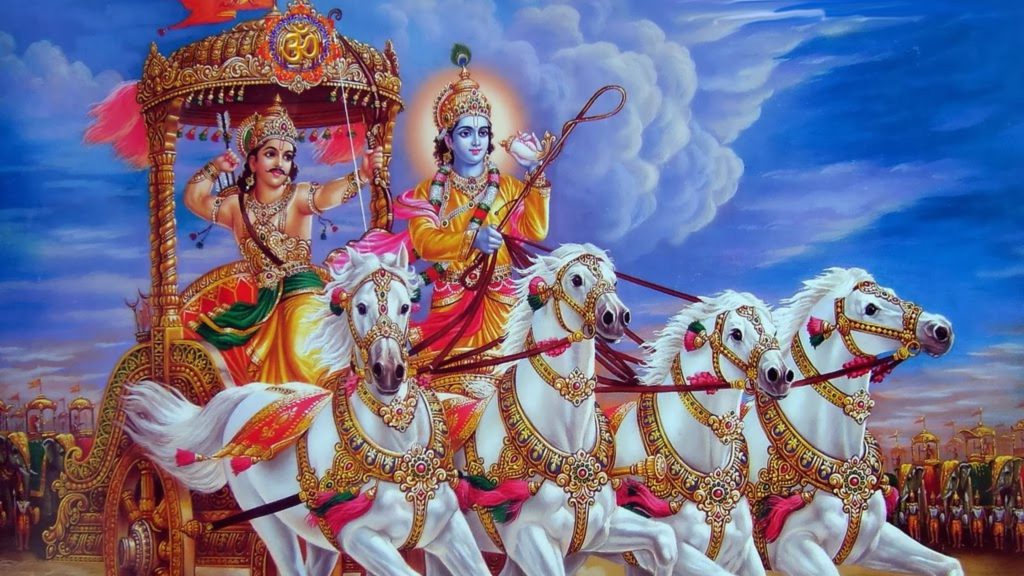Bhagavad Gita: Unveiling 7 Life-changing Timeless Lessons by Lord Krishna
Embark on a transformative journey through the sacred verses of the Bhagavad Gita, discovering timeless wisdom that transcends ages, offering profound insights into duty, spirituality, and the art of living a balanced and fulfilling life.

Bhagavad Gita: In the vast tapestry of ancient Indian philosophy, the Bhagavad Gita stands as a beacon of timeless wisdom, offering profound insights into life, duty, and the nature of existence. The Bhagavad Gita, often referred to as the Gita, is a 700-verse Hindu scripture that is part of the Indian epic Mahabharata.
At the heart of this sacred scripture is Lord Krishna, the divine charioteer, imparting guidance to Arjuna on the battlefield of Kurukshetra.
So, how did Lord Krishna empower Arjuna to practise righteousness and save the world? What lessons encouraged Arjuna to establish an exemplary identity? How does the essence of Bhagavad Gita affect our lives?
Let’s embark on a journey through the Gita’s teachings, discovering the gems that continue to resonate across centuries, and understand its deeper meaning in leading an awakened life.

1. The Essence of Dharma; Fall of Fear (Chapter 2, Verse 47):
“Your right is to perform your duties only, but never to its fruits. Let not the fruits of action be your motive, nor let your attachment be to inaction.”
Central to the Bhagavad Gita is the concept of Dharma – one’s righteous duty. Arjuna faces a moral dilemma on the battlefield, torn between fighting in a war that involves his own relatives and renouncing the battle altogether. To this, Lord Krishna emphasises that one must perform their duties selflessly, without attachment to the fruits of their actions. By doing so, individuals align themselves with the cosmic order, contributing to the harmony of the universe.
2. The Impermanence of Life; Accept the change (Chapter 2, Verse 14):
“O son of Kunti (Arjuna), the contact of the senses with the worldly objects gives rise to fleeting perceptions of happiness and distress. They are non-permanent and come and go. Bear them patiently, O Arjuna.”
In the Gita, Lord Krishna imparts the profound truth of life’s impermanence. He encourages Arjuna to recognize the transient nature of the physical realm and focus on the eternal soul. This teaching invites reflection on the ephemeral nature of success, failure, joy, and sorrow, urging individuals to seek a higher, enduring purpose.
Understanding that the external world is ever-changing helps individuals develop resilience and an inner strength that is not dependent on external circumstances.This timeless lesson inspires individuals to confront challenges with a composed mind and unwavering determination.
Virtual Puja Experience,
Anytime, Anywhere.
Book Your Puja Now & Ensure A Spiritual Experience For You & Your Loved Ones.
3. The Yoga of Devotion (Bhakti); Surrender to God (Chapter 9, Verse 22):
“To those who are constantly devoted and who worship Me with love, I give the understanding by which they can come to Me.”
The Bhagavad Gita introduces various paths to spiritual realisation, with Bhakti Yoga being one of the most prominent. Lord Krishna emphasises the power of unwavering devotion to the divine, highlighting that true surrender leads to liberation. Through devotion, individuals cultivate a deep connection with the divine, transcending the limitations of the material world.Therefore, all that you do, direct and dedicate your actions in the name of God, and you’ll have nothing to worry about. You will attain freedom from worries and experience true bliss.
4. Detachment and Duty; Selfless Action (Chapter 2, Verse 14):
“O son of Kunti, the nonpermanent appearance of happiness and distress, and their disappearance in due course, are like the appearance and disappearance of winter and summer seasons. They arise from sense perception, O scion of Bharata, and one must learn to tolerate them without being disturbed.”
Lord Krishna advocates for performing actions with detachment, emphasising that individuals should focus on their duties without being attached to the outcomes. Just as seasons change, so do the sensory perceptions, and that nothing stays forever. This teaching fosters a balanced approach to life, where one engages wholeheartedly in their responsibilities while maintaining equanimity in success and failure.
5. The Science of Self-Realisation; Know and Accept Thyself (Chapter 6, Verse 5):
“A person is said to be established in self-realisation and is called a yogi when he is fully satisfied by virtue of acquired knowledge and realisation. Such a person is situated in transcendence and is self-controlled. He sees everything—whether it be pebbles, stones, or gold–-as the same.”
Lord Krishna says that neither does the body belong to you, nor do you belong to the body. All the elements- air, water, earth, fire, and sky are part of the universe and will merge with it one day. So what are you made of and who are you? – Attempt to understand that!
Hence, The Gita unravels the layers of the self, guiding individuals towards self-realisation. Lord Krishna elucidates the distinction between the physical body and the eternal soul, encouraging introspection and the pursuit of knowledge to attain true understanding.
6. Universal Brotherhood; Equality and Oneness (Chapter 6, Verse 29):
“A true yogi perceives the self in all beings and all beings in the self. Such a person, who sees unity in diversity, is untouched by dualities and free from envy.”
The Bhagavad Gita advocates for the oneness of all beings, irrespective of caste, creed, or social status. Lord Krishna emphasises that the divine resides in every heart, fostering a sense of universal brotherhood. This teaching encourages individuals to treat others with empathy, compassion, and respect.
7. Recognition of the Divine; Rise of The Universal Form (Chapter 6, Verse 32):
“He who sees Me everywhere and sees everything in Me, I am not lost to him, nor is he lost to Me.”
The Bhagavad Gita encourages to acknowledge the divine presence in all aspects of life. By recognizing the sacred in the ordinary, one attains a deeper understanding of the divine plan. A true yogi is therefore, the one who has attained a high level of spiritual realisation, sees the divine presence in every entity and recognizes the unity of all existence.
Last Thoughts
In conclusion, the Bhagavad Gita unfolds as a guide to righteous living, offering profound insights into the nature of existence. Its teachings transcend cultural and temporal boundaries, resonating with seekers of truth and spirituality, across the ages. As we delve into the wisdom of the Gita, we discover a timeless source of inspiration, urging us to navigate the complexities of life with wisdom, compassion, and a deep understanding of our true nature.

Frequently Asked Questions
1. What is the Bhagavad Gita?
– The Bhagavad Gita is a 700-verse Hindu scripture that is part of the Indian epic Mahabharata. It is a conversation between Prince Arjuna and the god Krishna, who serves as his charioteer.
2. What is the central theme of the Bhagavad Gita?
– The central theme of the Bhagavad Gita is the concept of dharma, which is one’s righteous duty. It also explores various paths to spiritual realisation, the nature of the self, and the importance of selfless action.
3. How does the Bhagavad Gita address the concept of duty (Dharma)?
– The Gita emphasises performing one’s duties selflessly and without attachment to the results. Lord Krishna advises Arjuna to fulfil his Kshatriya duty as a warrior, setting an example for individuals to follow their respective duties with dedication.
4. What are the different paths to spiritual realisation mentioned in the Bhagavad Gita?
– The Bhagavad Gita outlines several paths, including Karma Yoga (the path of selfless action), Bhakti Yoga (the path of devotion), Jnana Yoga (the path of knowledge), and Raja Yoga (the path of meditation). Each path caters to individuals with different temperaments and inclinations.
5. How does the Bhagavad Gita address the concept of detachment?
– Lord Krishna advises practising detachment, emphasising that individuals should perform their duties without being attached to the outcomes. This teaching encourages a balanced approach to life, where one engages in actions with dedication but remains unaffected by success or failure.
6. What is the significance of universal brotherhood in the Bhagavad Gita?
– The Gita promotes the idea of universal brotherhood by recognizing the divine presence in every being. Lord Krishna underscores that all beings are interconnected, transcending social boundaries, and encourages treating others with empathy, compassion, and respect.





